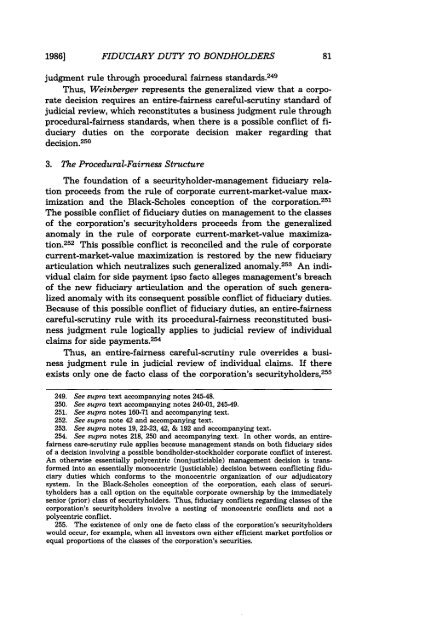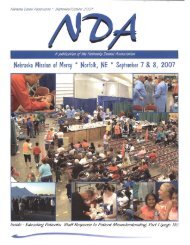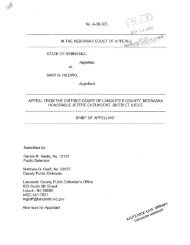Financial Articulation of a Fiduciary Duty to Bondholders with ...
Financial Articulation of a Fiduciary Duty to Bondholders with ...
Financial Articulation of a Fiduciary Duty to Bondholders with ...
Create successful ePaper yourself
Turn your PDF publications into a flip-book with our unique Google optimized e-Paper software.
1986]<br />
FIDUCIARY DUTY TO BONDHOLDERS<br />
judgment rule through procedural fairness standards. 249<br />
Thus, Weinberger represents the generalized view that a corporate<br />
decision requires an entire-fairness careful-scrutiny standard <strong>of</strong><br />
judicial review, which reconstitutes a business judgment rule through<br />
procedural-fairness standards, when there is a possible conflict <strong>of</strong> fiduciary<br />
duties on the corporate decision maker regarding that<br />
decision. 250<br />
3. The Procedural-Fairness Structure<br />
The foundation <strong>of</strong> a securityholder-management fiduciary relation<br />
proceeds from the rule <strong>of</strong> corporate current-market-value max-<br />
25 1<br />
imization and the Black-Scholes conception <strong>of</strong> the corporation.<br />
The possible conflict <strong>of</strong> fiduciary duties on management <strong>to</strong> the classes<br />
<strong>of</strong> the corporation's securityholders proceeds from the generalized<br />
anomaly in the rule <strong>of</strong> corporate current-market-value maximization.<br />
252 This possible conflict is reconciled and the rule <strong>of</strong> corporate<br />
current-market-value maximization is res<strong>to</strong>red by the new fiduciary<br />
articulation which neutralizes such generalized anomaly. 25 3 An individual<br />
claim for side payment ipso fac<strong>to</strong> alleges management's breach<br />
<strong>of</strong> the new fiduciary articulation and the operation <strong>of</strong> such generalized<br />
anomaly <strong>with</strong> its consequent possible conflict <strong>of</strong> fiduciary duties.<br />
Because <strong>of</strong> this possible conflict <strong>of</strong> fiduciary duties, an entire-fairness<br />
careful-scrutiny rule <strong>with</strong> its procedural-fairness reconstituted business<br />
judgment rule logically applies <strong>to</strong> judicial review <strong>of</strong> individual<br />
claims for side payments. 25 4<br />
Thus, an entire-fairness careful-scrutiny rule overrides a business<br />
judgment rule in judicial review <strong>of</strong> individual claims. If there<br />
exists only one de fac<strong>to</strong> class <strong>of</strong> the corporation's securityholders, 255<br />
249. See supra text accompanying notes 245-48.<br />
250. See supra text accompanying notes 240-01, 245-49.<br />
251. See supra notes 160-71 and accompanying text.<br />
252. See supra note 42 and accompanying text.<br />
253. See supra notes 19, 22-23, 42, & 192 and accompanying text.<br />
254. See supra notes 218, 250 and accompanying text. In other words, an entirefairness<br />
care-scrutiny rule applies because management stands on both fiduciary sides<br />
<strong>of</strong> a decision involving a possible bondholder-s<strong>to</strong>ckholder corporate conflict <strong>of</strong> interest.<br />
An otherwise essentially polycentric (nonjusticiable) management decision is transformed<br />
in<strong>to</strong> an essentially monocentric (justiciable) decision between conflicting fiduciary<br />
duties which conforms <strong>to</strong> the monocentric organization <strong>of</strong> our adjudica<strong>to</strong>ry<br />
system. In the Black-Scholes conception <strong>of</strong> the corporation, each class <strong>of</strong> securityholders<br />
has a call option on the equitable corporate ownership by the immediately<br />
senior (prior) class <strong>of</strong> securityholders. Thus, fiduciary conflicts regarding classes <strong>of</strong> the<br />
corporation's securityholders involve a nesting <strong>of</strong> monocentric conflicts and not a<br />
polycentric conflict.<br />
255. The existence <strong>of</strong> only one de fac<strong>to</strong> class <strong>of</strong> the corporation's securityholders<br />
would occur, for example, when all inves<strong>to</strong>rs own either efficient market portfolios or<br />
equal proportions <strong>of</strong> the classes <strong>of</strong> the corporation's securities.








